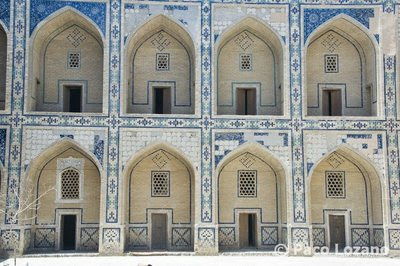**NOTE: A.D. 622 to the Present. Known for detailed arches and spectacular rugs, Islamic culture spread far beyond Istanbul taking root in the Middle East, North Africa, Europe, and Asia. This will be mentioned later on with India and Spain.
 Prayer Rug: Transylvanian Prayer Rug from Ushak, Turkey, and now lies in The Museum of Applied Arts, Budapest.
Prayer Rug: Transylvanian Prayer Rug from Ushak, Turkey, and now lies in The Museum of Applied Arts, Budapest. Madrasa: facade detail in Bukhara, Uzbekistan. Each arched bay houses a student's dormitory. Madrasa is a religious building such as a mosque, shrine, convent, or mausoleum.
Madrasa: facade detail in Bukhara, Uzbekistan. Each arched bay houses a student's dormitory. Madrasa is a religious building such as a mosque, shrine, convent, or mausoleum.  Arches: these are the 3 different types of arches. The first one is horseshoe arch and a main characteristic of Islamic architecture.
Arches: these are the 3 different types of arches. The first one is horseshoe arch and a main characteristic of Islamic architecture. Mihrab: from the Madrasa of Mimami, Isfahan, Iraq circa 1354, faced with a mosaic of glazed tiles 11ft. Mihrab is a prayer niche served to indicate the direction of Mecca.
Mihrab: from the Madrasa of Mimami, Isfahan, Iraq circa 1354, faced with a mosaic of glazed tiles 11ft. Mihrab is a prayer niche served to indicate the direction of Mecca. Sinan's Dome: located in Henri Sterlin, Geneva. This picture is the dome and 2 adjacent half domes from the ceiling of the Sulimaniye Mosque. Although the colour doesn't serve justice, the middle dome has a rich ochre colour and helps highlight the intricate detailing. The architect was Sinan.
Sinan's Dome: located in Henri Sterlin, Geneva. This picture is the dome and 2 adjacent half domes from the ceiling of the Sulimaniye Mosque. Although the colour doesn't serve justice, the middle dome has a rich ochre colour and helps highlight the intricate detailing. The architect was Sinan. Arabesque decoration: This tile matches a border frieze adorning the portal of the tomb of Sultan Mehmed I in Bursa. It has a deeply carved pattern of lattices formed by pairs of undulating vine scrolls. The arabesque lattices is complex, but clarity is achieved through the use of different colored glazes.
Arabesque decoration: This tile matches a border frieze adorning the portal of the tomb of Sultan Mehmed I in Bursa. It has a deeply carved pattern of lattices formed by pairs of undulating vine scrolls. The arabesque lattices is complex, but clarity is achieved through the use of different colored glazes. Stucco panel: from Samarra with ornate decoration.
Stucco panel: from Samarra with ornate decoration.More decorative details:

 Wooden frieze: Egypt
Wooden frieze: Egypt  Stucco decoration: Ibn Tulun Mosque ; Egypt.
Stucco decoration: Ibn Tulun Mosque ; Egypt.


amazing..we appreciate islamic arcitechture in past time,we hope islam will be better in the future. Subhananallah
ReplyDeleteThank you very much for visting the site, I do appreciate it! I completely understand I am hopeful that a change will come!
ReplyDeleteIman
Very nice blog and articles. I am realy very happy to visit your blog. Now I am found which I actually want. I check your blog everyday and try to learn something from your blog. Thank you and waiting for your new post. fasting in islam,
ReplyDeleteSo an industrial coffee machine will help save money by not having to change a conventional coffee maker year after year, even in less time, because these are not manufactured for exhaustive use. berista.mx
ReplyDelete